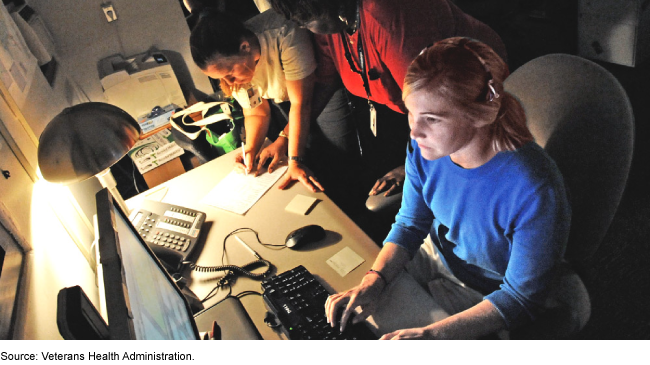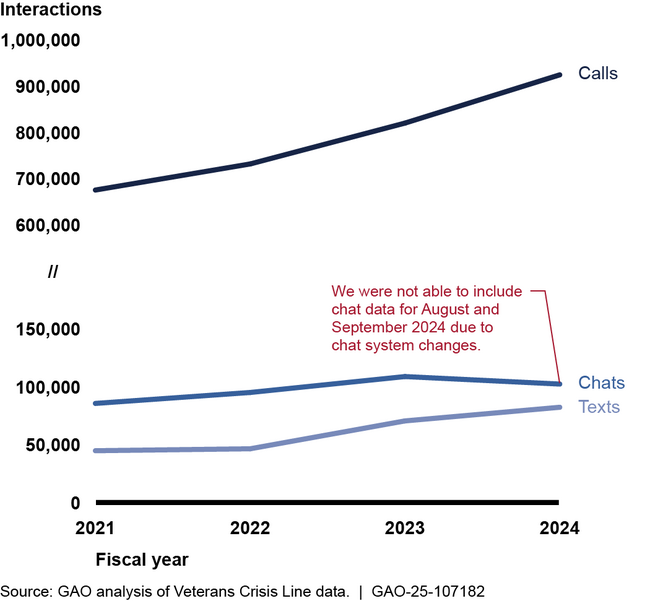Veterans Crisis Line: Actions Needed to Better Ensure Effectiveness of Communications with Veterans
Fast Facts
Suicides occur among veterans at twice the rate of nonveterans. Preventing them is a top priority of Veterans Affairs. To help, it runs the Veterans Crisis Line, a 24/7 phone, chat, and text service.
We looked at some challenges facing the crisis line. For example, staff handle multiple chat and text interactions at once, which makes it harder for staff to focus and can lead to burnout.
Another challenge is routing calls from "complex needs" callers—those who are abusive or call frequently. If these calls go to responders who aren't trained for them, it can cause stress and put callers at risk.
Our recommendations address these issues and more.

Highlights
Why This Matters
An average of 17.6 U.S. veterans died by suicide per day in 2022—the most recent data available. This was more than double the rate for nonveterans. Preventing suicide is a top stated priority of the Department of Veterans Affairs (VA). VA runs the Veterans Crisis Line: a 24/7 phone, chat, and text service, staffed by crisis responders who support veterans and their family and friends (i.e., customers).
GAO Key Takeaways
Crisis line data show it had about 3.8 million customer interactions from fiscal year 2021 through 2024, with the number increasing each year (see figure). We found the crisis line faces challenges:
- Customers with complex needs. The crisis line provides specialized training to responders in a unit that addresses complex callers. However, these callers are increasingly being routed to responders who may not have received the training, raising service quality and staffing concerns that could put customers at risk.
- Chat and text. Procedures for staff in this unit—such as responding to more than one customer at once—as well as how the unit is staffed may have adverse effects, including increased customer wait times and responder burnout, which could also put customers at risk.
Further, in July 2024, VA determined that, as a non-clinical service, the procedure the crisis line was using to disclose incidents to customers or their representatives in cases when actions or inactions created a significant risk of harm to the customer was not applicable. The crisis line withdrew the procedure and a new one has not been established. This runs counter to VA’s goal of building trust with stakeholders through transparency and accountability.
Number of Veterans Crisis Line Customer Interactions, Fiscal Years 2021-2024

How GAO Did This Study
We obtained, reviewed, and analyzed crisis line documents as well as data from fiscal years 2021 through 2024; interviewed crisis line officials; surveyed all crisis line responders and conducted interviews with a non-generalizable sample of eight responders.
Recommendations
VA should ensure the crisis line more comprehensively assesses risks of adverse effects for its customers with complex needs and those using chat and text, making adjustments to procedures and staffing, as needed; and ensure that it has a procedure for disclosing incidents. VA agreed with GAO’s recommendations and identified steps VHA plans to take to implement them.
Recommendations for Executive Action
| Agency Affected | Recommendation | Status |
|---|---|---|
| Department of Veterans Affairs | The Under Secretary for Health should ensure the VCL more comprehensively assesses the risks of adverse effects associated with its procedure for immediately routing CWCN callers to main phone line responders when there is no availability in the CWCN unit. Such an assessment should include comparing the quality of CWCN calls handled by main line responders with those handled by CWCN-trained responders. Depending on the results of the assessment, the VCL should make adjustments to its procedure for routing CWCN calls and to how it staffs the CWCN unit to better meet the needs of CWCN callers, as appropriate. (Recommendation 1) |
When we confirm what actions the agency has taken in response to this recommendation, we will provide updated information.
|
| Department of Veterans Affairs | The Under Secretary for Health should ensure the VCL more comprehensively assesses the risks of adverse effects associated with its digital services procedures, making modifications to them and to how it staffs the unit, as appropriate. Such an assessment may require obtaining and analyzing additional data on digital services responder workload, such as time spent interacting with customers as well as on documentation after interactions. (Recommendation 2) |
When we confirm what actions the agency has taken in response to this recommendation, we will provide updated information.
|
| Department of Veterans Affairs | The Under Secretary for Health should ensure the VCL instructs its chat platform provider to develop a solution to address chats being abandoned after customer redirection to unavailable responders. (Recommendation 3) |
When we confirm what actions the agency has taken in response to this recommendation, we will provide updated information.
|
| Department of Veterans Affairs | The Under Secretary for Health should establish a procedure for the VCL, as a non-clinical service, that identifies the types of incidents that warrant disclosure to customers or their representatives and outlines a process for disclosing such incidents, or direct the VCL to develop such a procedure. (Recommendation 4) |
When we confirm what actions the agency has taken in response to this recommendation, we will provide updated information.
|
